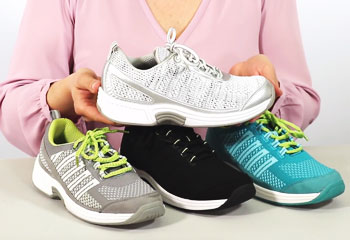When it comes to comfortable shoes that provide ample support, HOKA and Orthofeet are two of the most popular brands. But with so many options to choose from, how do you know which shoe is right for you?
This comprehensive guide compares the key features of HOKA and Orthofeet shoes to help you find the perfect pair. We’ll look at criteria like fit, cushioning, orthotic accommodation, plantar fasciitis relief, styles, and more. Read on for an in-depth analysis.
A Brief Comparison Table
| Feature | HOKA | Orthofeet |
| Fit | Wide toe box, narrow heel | Wide toe box, wide heel |
| Cushioning | Maximum cushioning | Moderate cushioning |
| Orthotic Support | Excellent | Very good |
| Plantar Fasciitis Relief | Excellent | Very good |
| Styles | Athletic, casual, dress | Casual, athletic, dress |
| Weight | Heavier | Average weight |
| Durability | Average | Excellent |
| Motion Control | Very good | Excellent |
| Arch Support | Excellent | Very good |
| Terrain | Mostly roads | Varied terrain |
| Price | $$ | $$$ |
Overview of HOKA Shoes

HOKA shoes are renowned for their thick, cushioned midsoles that provide a soft, pillowy ride. Key features include:
- Proprietary EVA foam midsole for maximum shock absorption and comfort
- Meta-Rocker geometry encourages smooth heel-to-toe transition
- Wide toe box accommodates bunions and wide feet
- Low heel drop promotes natural foot positioning
- Lightweight despite thick cushioning
- Excellent for road running and walking
- Models for trail running available
HOKA prioritizes cushioning and comfort over everything. If you want an ultra-plush shoe, HOKA is likely the best choice. The thick midsole excels at absorbing impact to reduce pain from conditions like plantar fasciitis.
However, some downsides exist. The excessive cushioning can feel unstable laterally. Traction isn’t ideal for technical trails. And the foams tend to compress over time.
Overview of Orthofeet Shoes
Orthofeet specializes in extra depth shoes engineered to accommodate foot conditions. Key features include:
- Lightweight cushioning with ergonomic arch support
- Seam-free interior lining prevents irritation
- Extra depth toe box relieves pressure on bunions and hammertoes
- Wide toe box and wide heel provide stability
- Orthotic inserts can be removed to fit custom orthotics
- Excellent motion control for overpronation
- Durable air cushioned soles with Ergonomic-Stride design
- Models for walking, athletic shoes, and dress shoes
Orthofeet optimizes shoes to alleviate pain and pressure for sensitive feet. The removable insoles, spacious toe boxes, and arch support provide comfort for long wears. Stability and motion control features help correct overpronation.
The trade-off is less plush cushioning than brands like HOKA. And some styles lean orthopedic in appearance. But overall Orthofeet excels at accommodating foot issues.
Also Read: Choose Between New Balance 619 And 608.
Key Differences Between HOKA and Orthofeet
Now let’s dive into a detailed feature-by-feature comparison of HOKA vs Orthofeet.

· Fit
HOKA shoes have a wide toe box to relieve pressure on bunions and forefoot issues. However, they tend to run narrow in the heel. Those with wide feet may experience heel slippage.
Orthofeet has a wide toe box and a wider heel. The extra depth design and spacious interior provide ample room for problem feet. Orthofeet offers better fit for wide feet.
· Cushioning
The maximally cushioned midsole is the hallmark of HOKA shoes. Models like the Bondi use a full compression molded EVA foam midsole up to 5.5cm thick. This provides the softest, most shock-absorbing ride possible in a shoe.
Orthofeet uses open cell PU and air cushioning foam in the midsole. The cushioning provides good comfort and shock absorption. But it’s not as plush or thick as HOKA. Those seeking maximum cushioning will prefer HOKA.
· Orthotic Support
HOKA shoes have removable foam insoles that can be replaced with custom orthotics. Their straight last and roomy toe box also readily accommodate orthotics. Models like the Gaviota and Arahi have firmer J-shape midsoles well-suited to custom inserts.
Orthofeet uses orthotic-friendly insoles that can be removed to insert custom orthotics. The extra depth design and seam-free interior provide space for inserts. Both brands work very well with orthotics, with HOKA having a slight edge.
· Plantar Fasciitis Relief
The thick cushioned midsoles of HOKA shoes provide excellent shock absorption. This reduces pressure on the plantar fascia and heel for superior plantar fasciitis relief. Soft foam models like the Bondi and Clifton are exceptionally good for PF.
Orthofeet provides good cushioning and arch support to aid plantar fasciitis. Features like air cushioning and ergonomic sole design offload pressure on the fascia. But the cushioning isn’t as plush as HOKA. HOKA has a slight advantage for plantar fasciitis.
· Styles
HOKA started with a focus on maximalist running shoes. They now offer many lifestyles including walking shoes, casual sneakers, and dress shoes. But the selection still centers on athletic performance styles.
Orthofeet has a broader range spanning orthopedic walkers, athletic shoes, casual sneakers, sandals, and dress shoes. There are more variety and options for those wanting orthopedic comfort across many applications.
Also Read: Comparison Between Nortiv 8 and Columbia
· Weight
The thick midsoles of HOKA shoes add weight, with models averaging 10-12oz. However, they remain reasonably lightweight for their cushioning level. Advanced foams like PROFLY provide responsive oomph for such plush shoes.
Orthofeet uses lightweight cushioning foams like air blown PU to keep weights reasonable. Shoes average around 10-12oz depending on the model. For the cushioning level, Orthofeet offers lighter weight than you’d expect.
· Durability
The soft compressed EVA foam in HOKA tends to compress and lose bounce over time. Outsoles can also show wear quickly on asphalt. Average miles are around 300-400 before cushioning breaks down.
Orthofeet outsoles use long-wearing materials like rubber and EVA. The strutted heel counter, firm midsole materials, and ergonomic shape improve durability and lifespan. These can last 500+ miles before losing comfort.
· Motion Control
HOKA relies on a curved outsole shape to provide some guidance against overpronation. This works well for mild to moderate overpronators. Models like the Arahi have firmer midsole edges for added stability.
Orthofeet uses multi-density foam midsoles and firm heel counters to prevent overpronation. Pronation correction is a priority in Orthofeet’s Ergonomic Stride design. Orthofeet offers better motion control for severe overpronators.
· Arch Support
HOKA incorporates arch support into the shape of the midsole. Many models have a raised J-shaped midsole to cradle the arch. This provides excellent medium to high arch support integrated into the cushioning system.
Orthofeet uses contoured, orthotic-quality arch support insoles. These support various arch types from flat feet to high arches. The arch support is very good, though not molded seamlessly into the midsole like with HOKA.
· Terrain
Originally engineered for roads, HOKA outsoles provide great traction and shock absorption on asphalt. Many models are still road-focused, but trail and hybrid options exist for off-road. Deep lugs and aggressive treads accommodate varied terrain.
Orthofeet offers varied sole tread patterns optimized for walking or athletics. The designs readily flex and grip for indoor and outdoor use. While not specialized, Orthofeet works well for everyday mixed terrain. HOKA has more specialty designs for hardcore trails.
· Price
HOKA shoes retail between $130-$170 USD, firmly in the premium athletic shoe category. The proprietary foam midsoles come at a price. But the comfort and support justify costs for the right buyer.
Orthofeet retails between $145-$175 USD, also falling into the premium footwear bracket. Considering the orthopedic design, quality, and accommodation of foot issues, Orthofeet provides strong value. But the costs are higher than average sneakers.
Also Read: Comparison Between Shoes For Crews and Skechers
Frequently Asked Questions (FAQs)
Many podiatrists do recommend HOKA shoes due to the plush shock absorption. The thick cushioning and wide toe box help alleviate common foot pains like plantar fasciitis and bunions. Models with firmer midsoles also accommodate orthotics well.
While not labeled orthopedic, HOKA shoes provide excellent comfort and support for problem feet. The cushioning relieves pressure and impact, while the stable platform and optional motion control features aid conditions like overpronation. Overall, they serve many orthopedic needs.
Other top shoes brands that offer similar orthopedic comfort as Orthofeet include New Balance, Brooks Addiction/Beast, Saucony Echelon/Guide, and Asics. Models from these brands tend to have ample cushioning, support, and accommodation of foot issues.
Yes, HOKA shoes pair very well with custom orthotics. Models with removable insoles like the Gaviota, Arahi, and Bondi readily fit orthotic inserts. Some models even have firmer midsole areas and intrinsic stability technologies that complement orthotics for overpronators.
Also Watch This Review Video:
Final Thoughts
In the battle of HOKA vs Orthofeet, both brands offer excellent comfort and support. HOKA specializes in ultra-cushioned shoes that absorb impact and strain. Orthofeet focuses on foot-friendly designs made to accommodate specific issues.
Those with wide feet, plantar fasciitis, and who want plush shock absorption can’t go wrong with HOKA. If you need customizable orthotics and stability for overpronation, Orthofeet is likely the better choice.
No matter your foot type, analyzing your needs against the Pros and Cons of each brand helps determine the ideal pair. Taking the time to find the right shoes provides happy feet for miles to come!

